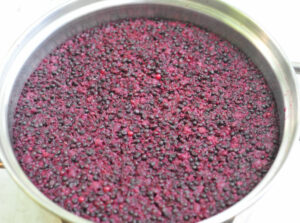This year was another bumper crop for blackberries. Those invasive pest-plants grow fast, have nasty thorns, and are immune to most chemical herbicides unless you use WAY more than you should be within a mile of a garden or children. They have one redeeming quality, and that is the berries are tasty and plentiful in August (or there about). Some years the weather is such that they are not ripe until one day they are, and the next they are moldy. Sometimes the peak beautifully for nearly a month, and you can go picking every day.
In 2017 we had a fantastic year, I got in a groove of picking and making jam, and suddenly discovered I’d made about 11 gallons of it. Still have some, don’t really need to make more. It keeps well, but I don’t like to give away 4 year old jam for Christmas presents. So I made more this year, just a couple of gallons, because there was a lot of them. I have oft considered what else to do with them; I only have so much freezer space, and the other classic thing, blackberry wine, is of no use to me because I don’t drink. But I hate seeing a resource go to waste, so I decided I’d pick up some jugs and a few odds and ends, and pick some berries, mash them up, find some basic internet recipe, and see what happens.
Five gallons later…
Yeah.
Using this basic recipe. This sort of jug, more or less. Red Star red wine yeast. A little tube of yeast nutrient and bentonite clay as a settling agent. Auto-siphon similar to this. A little charred 5L barrel for a portion of it to “oak age” it. Some campden tablets. A few normal kitchen odds and ends, some sugar, and a lot of time. And a lot of learning. A hundred cool or interesting details I’d never know if I had never tried it. Even for non-drinkers, I’d recommend, ahem, giving it a shot just so you can watch it and learn a bit about it. It’s a living product, not just an industrial commodity you can expect to be the same every time.
The first fermentation is in an open (but cloth-covered) pot. Quite active and frothy. Needs to be mashed down and stirred around every day. Top layer is 1-2 inches thick.

Second fermentation in the jug with an airlock to keep it anaerobic. It’s fun watching the little yeasties blowing bubbles in their jugs of rich red berry juice and syrup. It is not as frothy and big as the first, and you have to look closely to see it, but it’s absolutely alive and thriving in there! I added a bit of “yeast nutrient” to help it out, and a bit of bentonite clay to help solids settle out better; it give every appearance of being happy juice. Then I siphon it over into a new jug, (third fermentation, also anaerobic) with some more syrup and leave the dregs, called “lees” behind on the bottom inch or so, and let it percolate politely along until it either runs out of sugar to convert to alcohol, or the alcohol level gets so high it can’t continue. It’s actually been quite educational, and it totally smells like wine. I expect it will taste at least acceptable to those who tend to imbibe. The color is rich, and a lot of sediments are settling out. (There was a lot left in the initial pots, then more in the first jug of anaerobic). I’ll still likely have to “rack” it once more, leaving some behind so I lose most of the lees and have a clear and clean final product. I may fortify it with Everclear or pure grain alcohol (like port is fortified) to get the alcohol of part of it high enough so it doesn’t go bad if opened and not use entirely soon enough. I’ll likely turn some deliberately into vinegar, if none of the 5 jugs do that on their own, as fancy blackberry vinegar is something that I’m sure some members of the household would like.
It may end its existence as communion wine at the Order of St Possenti, but that’s a ways off, yet. If it’s passable, it may become an annual tradition. Life is good, if strange.